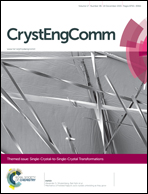Reversible solid to solid transformation in a crystalline state gas–solid reaction under ambient conditions: Fe–N(pyridine) bond formation at the expense of Fe–OH2 bond breaking and vice versa†
Abstract
The non-porous crystalline state of a trinuclear iron cluster containing compound [Fe3(μ3-O)(μ2-CH3COO)6(C5H5NO)2(H2O)]ClO4·3H2O (1) demonstrates a series of crystalline state reactions that can be stimulated by an external substrate, such as methanol or pyridine. This simple trinuclear {μ3-O} cluster [Fe3(μ3-O)(μ2-CH3COO)6(C5H5NO)2(H2O)]1+ exhibits reversible gas–solid reactions driven by the ligand exchange at one of its metal centres that involve Fe–OH2 bond breaking and Fe–N(pyridine) bond formation in the solid state in a reversible crystal to crystal transformation. The gas–solid interface reactions have been confirmed by IR spectroscopy and powder X-ray diffraction studies. A classical trinuclear iron {μ3-O} cluster with a slight modification in its basic molecular structure opens up new possibilities that can find applications in the development of multi-functional materials. The reversible solid to solid transformations in the present article have been established by various spectroscopic arguments.

- This article is part of the themed collection: Single-Crystal-to-Single-Crystal Transformations

 Please wait while we load your content...
Please wait while we load your content...